Setcreasia purpurea
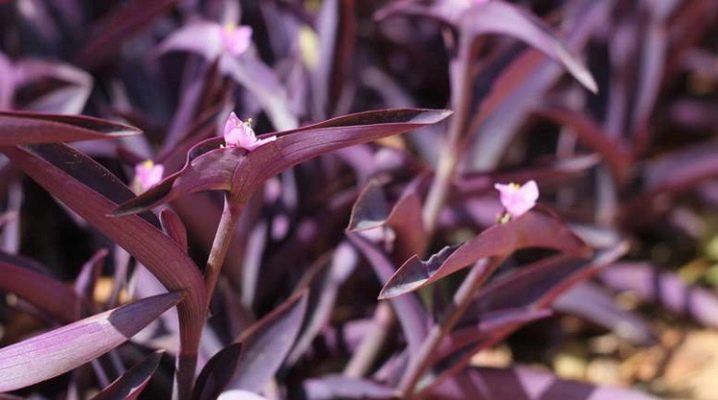
Setcreasia is a beautiful plant that will appeal to everyone who is passionate about botanical color. Simply put, purple color can make it the most visible plant in a home greenhouse, or on a single window sill. And I am glad that this is not the most capricious flower that can take root even among those who are far from the nickname "green hand".
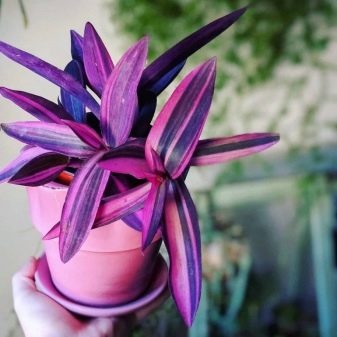
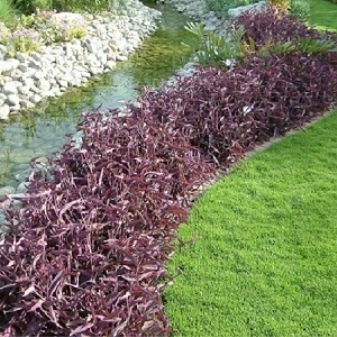
Description
Setcreasia purpurea (tradescantia pale, purpurea setcreasea) is an evergreen perennial characterized by long stems and pointed leaves. She belongs to the commeline family. Wild netcreasia grows in the east of Mexico, on the shores of the Gulf of Mexico. Today it is often used as a garden plant in the tropics and subtropics, and in temperate latitudes it is a home flower. Rare enough, but still not exotic. Description of netcreasia:
- an ampel plant, which can reach 80 cm in length in a couple of years (and then growth will stop);
- the leaves grow in a checkerboard pattern, the shape is broad-lanceolate;
- the inner part of the leaves with small whitish villi;
- the stems and the surface of the leaf plates are royal purple, as the foliage ages, it will fade, become slightly turquoise;
- it has powerful, fleshy stems;
- the underside of the leaves is deep purple;
- Setcreasia flowers are pink or pink-purple, 3 petals each;
- the flowering period is long - from early spring to late summer.
If you want to extend the flowering period, or at least maintain it, you need to pick off the flowers in a timely manner. By the way, the flower can be partially considered medicinal. It relieves pain in rheumatism: a sheet of netcreasia is warmed up and applied to the sore spot for 5 hours. And in order to heal the wounds as soon as possible, the leaves of the plant are crushed to gruel and applied to the inflamed area. Also, the flower is considered an excellent absorbent, which picks up harmful impurities from the air, that is, it cleanses it, moisturizes it. It also absorbs electromagnetic radiation, which is very important for modern apartments.
It can be grown in the house even for allergy sufferers, the plant is completely safe in this sense.
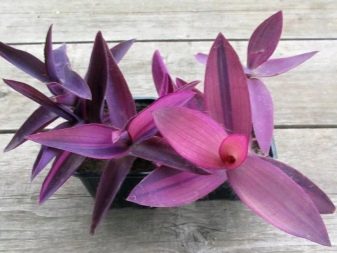
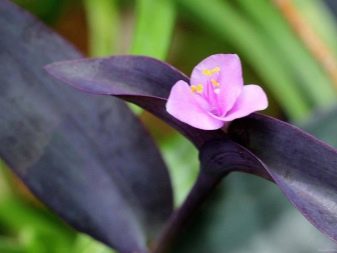
Varieties
To grow this flower at home, you need to choose the appropriate type. The houseplant is of the following varieties.
- Green. Light green leaves are not the most common option for this crop. Their leaflets are pointed at the tops, and they cover the stem with a stalk around the circumference. When blooming, small white flowers will appear, collected in bunches.
- Purple. In this species, leaf pubescence is very noticeable. The top side is purple, but the bottom is purple. The shoots have falling internodes. The buds are pink or pinkish with purple. This plant is almost always cultivated as an ampelous crop.
- Variegated. On the leaf plates of this plant, mutated cells of a lighter color can be seen. And these zones add originality to the flower. And so that this feature does not pass, it is impossible to treat the plant with mineral complexes with a large amount of nitrogen.
- Striped. Herbaceous form with creeping stems. The leaves have an unusual color, on a purple base there are white longitudinal stripes, and the lower part of the leaves has a pale pink undertone. Flowering is virtually invisible because the inflorescences are very small. Over time, old shoots become brittle, brittle, they can break under their own weight, even just from touch.
The purple variety of netcreasia has a fruit capsule. Planted in pots or vases, in various decorative containers suitable for this, the plants grow very quickly, form a dense mass. In a year, pale Tradescantia grows by about 30 cm, which is quite a lot. But over time, its decorative effect, alas, will be lost. Therefore, the flower needs to be artificially rejuvenated, and this is an important part of caring for it.
Moreover, for the summer period, the netcreasia can be planted in flower beds, and then dug up and returned home. This is beneficial for the plant, if everything is done carefully, of course.

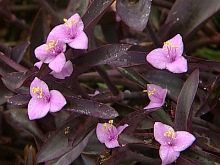

Landing
It is better if the planting occurs in late March - early April, at which time the growth potential is at its highest. But if necessary, do not wait for a suitable date, you can plant and transplant. The plant is quite tolerant of transplanting, tolerates it calmly.
What else you need to know about planting meshcreasia.
- Capacity. Both plastic and ceramic pots will do, it's a matter of taste. Although it is worth considering that in ceramic, evaporation is faster, since the material has pores. There must be drainage holes in the bottom of the container in order to establish the outflow of excess water. The pot should be the same height as the width, but may be slightly wider. And it must certainly be stable, because as soon as the flower grows, the container is easy to overturn.
- Priming. You can buy it ready-made, at a flower shop or garden market. The main thing is that the soil mixture is loose and nutritious. And in order to increase the friability to the required parameters, perlite, vermiculite or coarse river sand are used. And some of the above is added in a fraction of 1/3 to the total volume, and then the soil is mixed. But you can do it yourself: mix turf soil, compost, quartz sand (coarse grained) in equal proportions, mix, add a little charcoal to suppress the development of the fungus.
- Technique. Drainage is laid at the bottom of the pot with a 5-centimeter layer. On top of it is the soil. Then the roots are laid out as delicately as possible so that they lie in different directions. The remaining space is filled with earth to the very top of the container.
Immediately after planting / transplanting, the flower can be watered abundantly. After that, the dredge will settle predictably. But then you need to see if the earth has settled on the leaves - this should not be.
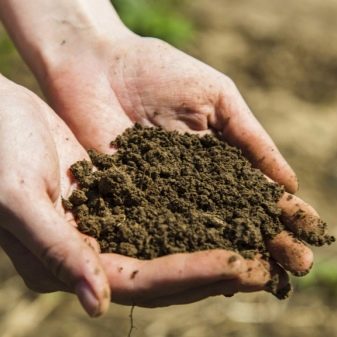
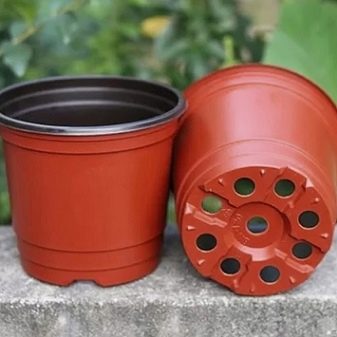
Home care
The care is comprehensive, but not to say that it requires a lot of effort. Problems don't happen very often. For example:
- if old leaves of tradescantia die off quickly, it is probably a matter of low air humidity, which is easily regulated;
- if the flower is stretched, small leaves are formed - there is little light;
- if spots appear on the leaves, probably the fact is that after spraying, droplets of moisture remain, and the netcreasia is faced with sunburn;
- if the tips of the leaves dry out, this is a lack of moisture or a lack of space in the container.
And all these moments will be prevented by standard care.
Watering
If the soil is always slightly moist, the flower will grow well. But in the warm season, nevertheless, you should not frequent it with watering - 2 times a week is more than enough for netcreasia. Use soft, well-settled water at room temperature (or close to that) for irrigation. But the stagnation of liquid in the container leads to decay of the roots. To increase the humidity of the air, it would be nice to just put a container of water near the bush.
For example, an ordinary vase to look decorative besides. And also you can take a deep pallet, fill it with well-moistened expanded clay, and put a flower pot on top. In cold weather, do not water the netcreasia more than once a week. It is important to understand that a strong drying out of the substrate is dangerous for the plant. It is bad if heating devices work next to the plant - due to their action (dry air), the bush can dry out.
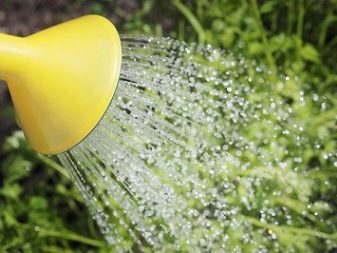

Top dressing
If the potted soil is depleted, you can feed it once a month. For this, mineskomplexes are used, created specifically for home crops. Top dressing is needed in spring and summer, in the cold there is no need for it. If the growth of the shoots is obviously slowed down, if there is no flowering, you can feed the bush more often - once every two weeks, for example.
Pruning
This procedure is carried out systematically. This is necessary to make the bush more compact and prettier, and look neat. If the length of the shoot is more than 0.4 m, it will become thinner, and the distance between the leaves will indeed increase. Which is not particularly good for ampelous culture, it will lose its decorative effect, and rather quickly. By the way, trimmed stem fragments can be used as cuttings.
It is also worth saying that the culture needs light very much. But at the same time, under direct ultraviolet light, it should be a maximum of 3 hours a day. It is good if the netcreasia occupies the eastern windowsill, and the light falls on it diffused.
With an acute lack of light, the purple plant will face thinning of the shoots, the foliage will fade. And if there is no way to move the flower to another place, it will need additional lighting. Phytolamps come to the rescue, under which the netcreasia should be most of the day.


Flower propagation
This can be done in several ways. Consider breeding options.
- Seeds. It is best to do this using damp sand. After disembarking, the container can be covered with glass or polyethylene. And during the period when the seeds germinate, you need to ventilate the sand and moisten it when it dries out.
- Cuttings or side shoots. With a sharp and sterile knife, you need to cut off the top of the stem (preferably 3-4 tops), where the leaves are healthy and strong. Then the slices should be sent to the water for rooting. However, instead of water, you can immediately take soil mixture. And when the roots appear, plants with them, from 3 to 5 pieces, need to be planted in one pot.
- By dividing the root. It is convenient to combine this process with a transplant. The plant is carefully dug out so as not to injure the roots. Then the roots are cleaned of the earth and washed under cold water. The root is divided into parts, planted in different containers.
Propagation by stem cuttings is probably the most popular practice. Their length should be 8 cm. The lower leaves from the cuttings must be removed, the selected samples must be rooted in a moistened mixture of peat and sand, or just in a glass of water. It can take almost a month to root, but often three weeks will be enough. In a glass of water, this is also successful. And the lodging stems root well themselves, simply by contacting the ground. If there is no problem to propagate the plant, but you want to have another netcreasia in the house, you can buy it. When buying, you need to evaluate the flower: elasticity and the absence of any signs of wilting should be inherent in it. It is also worth carefully examining the plant for pests - alas, it is not uncommon for a flower to "bring" pests home on itself, and this is a shop flower.
It should be noted that for For pathogens, netcreasia is not the most desirable object. But the scale insect and spider mite can infect the plant. A soap-alcohol solution, as well as a solution of soap and machine oil, will help to overcome the shield. Garlic solution and special products like "Akarina" and "Fitoverma" also help. And to save from a spider mite will help washing the plant with soapy water, garlic inhalations.
Yes, and it is better to ventilate the room more often - it is not difficult, but it is considered a good prevention against diseases and pests.
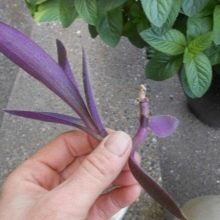
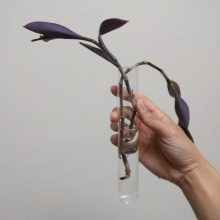
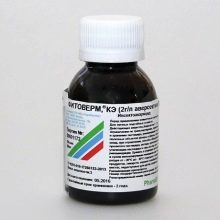































The comment was sent successfully.